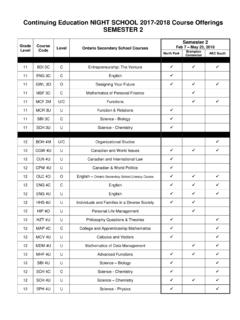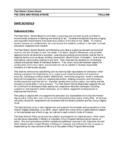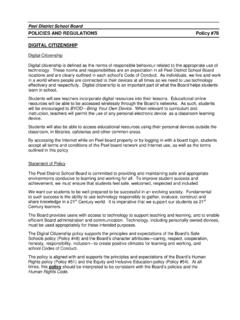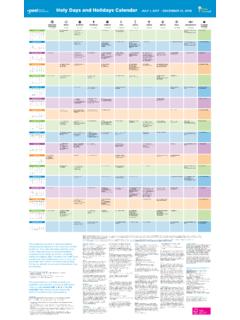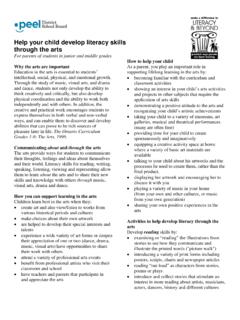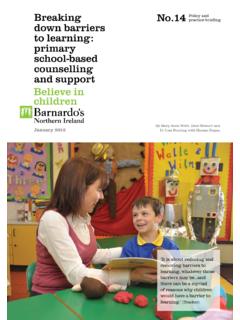Transcription of POLICIES AND REGULATIONS Policy #54 EQUITY …
1 POLICIES AND REGULATIONS Policy #54 EQUITY AND inclusive education The Peel District school Board is committed to providing and maintaining safe and healthy environments conducive to learning and working for all. The Board recognizes that encouraging, inclusive and respectful environments help students achieve to the best of their ability. To improve student success and achievement, we must ensure that students know they are safe, nurtured, welcomed, respected and included. Statement The EQUITY and inclusive education Policy , and related POLICIES and procedures, reflect the Board s philosophies and framework, as outlined in its strategic plan, the Report Card for Student Success. One of the Board s key goals is the following: "Achieve EQUITY for students and staff we provide EQUITY of access and opportunity for students and staff to learn, work and develop in an environment that is safe, nurturing, engaging, respectful and inclusive .
2 " The Policy is also aligned with and supports the expectations of the Board s Human Rights Policy #51, and the Safe Schools Policy to provide a learning and working environment free of negative factors. The Board upholds the principles of respect for human rights and fundamental freedoms enshrined in the Canadian Charter of Rights and Freedoms, Constitution Act, 1982 and confirmed in the Ontario Human Rights Code (the Code ). The Board and its staff are also committed to the elimination of all types of discrimination as outlined in Ontario s EQUITY and inclusive education Strategy (the Strategy ); and in the Ontario Ministry of education s (the Ministry ) Policy /Program Memorandum No. 119 (2009), Developing and Implementing EQUITY and inclusive education POLICIES in Ontario Schools. The Board recognizes the importance of EQUITY of opportunity, and EQUITY of access, to the full range and delivery of programs, services, and resources.
3 All are critical to achieving successful educational and social outcomes for those served by the school system, as well as those who serve the system. The Board is therefore committed to an equitable education system that upholds and reflects the principles of fair and inclusive education , which should permeate all POLICIES , programs, practices, and operations. This Policy has been developed in accordance with the EQUITY and inclusive education Strategy and the Ministry s Policy /Program Memorandum No. 119, and is consistent with the principles of the Code. The EQUITY and inclusive education Policy is divided into eight sections: Board POLICIES , Programs, Guidelines and Practices Shared and Committed Leadership school -Community Relationships inclusive Curriculum and Assessment Practices Religious Accommodation school Climate and the Prevention of Discrimination and Harassment Professional Learning Accountability and Transparency Board POLICIES , Programs, Guidelines and Practices The Board will ensure that its Policy review cycle will result in aligning and integrating the requirements of the Code, Policy /Program Memorandum No.
4 119, and the Strategy into all Board POLICIES , programs, procedures, and practices. Respect for the diverse perspectives of the entire school community will be reflected in all areas of the teaching, learning and administrative culture. We will make every effort to identify and remove discriminatory biases and systemic barriers that may limit access to, and opportunity for, effective student engagement and achievement. The goal is to ensure that schools are inclusive and reflect the makeup of their diverse communities. Guiding Principles Commit to the principles of EQUITY and inclusive education in all existing and new Board POLICIES , guidelines, strategic plans, practices, programs, procedures and organizational structures, consistent with the principles of the Code. Commit to removing systemic barriers to meet the needs of all students and staff.
5 Establish the appropriate mechanisms to ensure accountability for achieving these goals. Shared and Committed Leadership The Board subscribes to a leadership philosophy that inspires, empowers, and supports all stakeholders in a critical task implementing institutional practices and behaviours that cultivate EQUITY and inclusive education . The Board is committed to providing informed and shared leadership to improve student achievement and close achievement gaps. This will be done in part by identifying, addressing, and removing all barriers and forms of discrimination, consistent with the Code. The Board recognizes the critical connection between student leadership and improved student achievement, and will strive to include the student voice in implementing EQUITY and inclusive education . In accordance with the Ministry s Ontario Leadership Strategy, Board and school leaders will encourage and promote a collaborative approach to all dimensions of EQUITY and inclusive education one that ensures the participation of students, parents, unions, colleges and universities, service organizations and other diverse community partners.
6 Guiding Principles Recognize that informed leadership, committed to the principles of EQUITY and inclusive education for the elimination of systemic barriers, is required at all levels of the organization. Exercise this leadership in partnership with parents and diverse communities, to prepare students to live in a diverse society. school -Community Relationships The Board recognizes that the effective review, development, implementation and monitoring of EQUITY and inclusive education POLICIES and practices requires the involvement of all members of the entire school community. The Board values the assets that all stakeholders can bring to enable each student to learn effectively and enhance educational opportunities for all. The Board is committed to maintaining, developing and expanding collaborative relationships with parents, family members and diverse communities that support system and school improvement.
7 The Board will undertake to identify, examine, and remove barriers that may prevent full participatory school -community relations. Guiding Principles Increase the involvement of diverse communities in the development, implementation and monitoring of school board POLICIES , procedures and programs. Nurture effective collaborative relationships between the Board, its schools and its diverse communities, to ensure that we include and account for the perspectives, experiences and needs of all students, families, employees and communities. inclusive Curriculum and Assessment Practices Students learn both the explicit and underlying curricula. To ensure inclusive curriculum and assessment practices, in content and delivery, the Board needs to recognize and affirm the life experiences of all students. The Board recognizes that language proficiency is necessary for all students to achieve their academic potential, and that many students use a first language other than the two official Canadian languages.
8 The Board affirms and values the linguistic and cultural diversity of its population. The Board also acknowledges the importance of the guidance and counselling program in enabling all students to maximize their academic potential and realize their educational and career aspirations. Providing multiple opportunities for formative assessment (assessment for learning) is an essential component of an inclusive curriculum. This promotes varied means of measuring student learning and instruction, and varied opportunities to demonstrate learning. Effective evaluation includes researched best practices that truly reflect the current level of achievement of the student. A student perspective on assessment and evaluation practices increases the depth of understanding. Guiding Principles Promote an equitable and inclusive curriculum that offers a balance of perspectives; enables students to see themselves reflected in their learning; and provides students with the knowledge, skills, attitudes and behaviours needed to live in a diverse, complex world.
9 Students and teachers need to understand and respect all cultures, appreciate diversity and reject discriminatory attitudes and behaviours. Commit to a program of instruction that lets students achieve academic competence in English or French, and that respects and recognizes the international languages of students and their social and cultural language variations. The primary task is to provide all students with a proficiency in the language of instruction, to maximize their potential to learn, communicate and realize their aspirations. Deliver a comprehensive outcome-based guidance program that is equitable and inclusive , and train all counsellors to meet the individual needs of a diverse student population. Commit to accurate, equitable and bias-free evaluation, assessment and placement considering the diversity of the student population to ensure that all students are successful and can achieve their potential.
10 Deliver an instructional program that complies with Ontario's EQUITY and inclusive education Strategy, 2009 including the following: o give students and staff authentic and relevant opportunities to learn about diverse histories, cultures and perspectives; o support effective instructional practices that reflect the diverse needs and pathways of all students ( differentiated instruction); o support evidence-based instructional and assessment practices across all subjects o support Student Success strategies for secondary students that engage students by meeting their diverse needs and interests; o review assessment and evaluation POLICIES for discriminatory bias; o inform parents and students about board assessment and evaluation POLICIES and practices; o ensure parents understand (linguistically and culturally) the assessment and evaluation POLICIES and practices.

